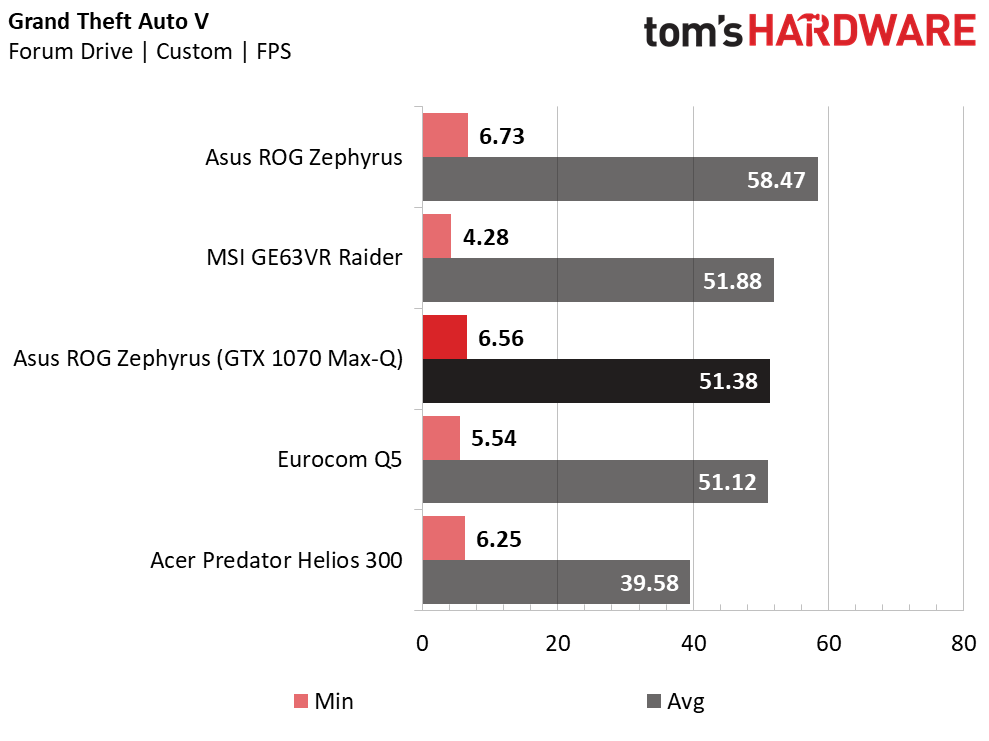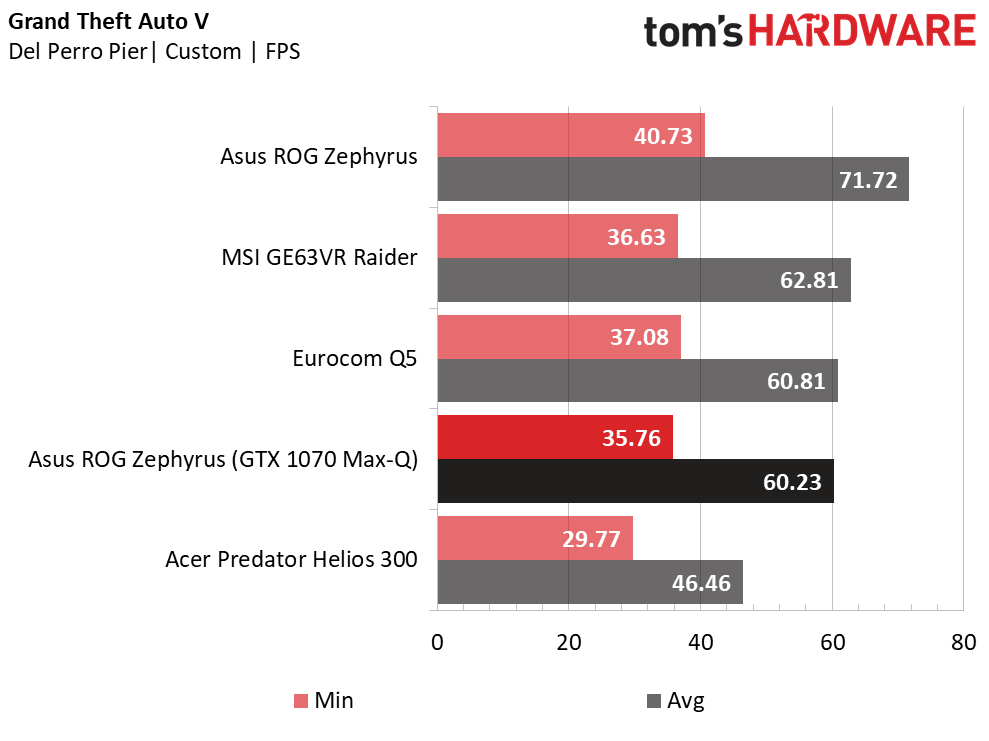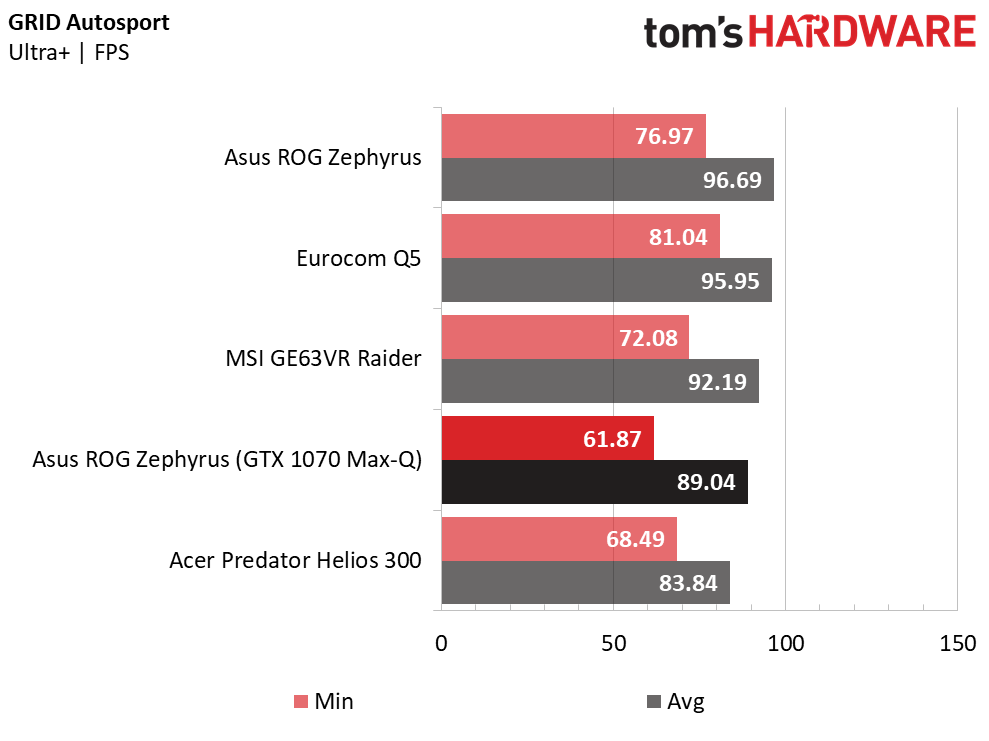Asus ROG Zephyrus (GTX 1070) Max-Q Gaming Laptop Review
Why you can trust Tom's Hardware
Gaming Benchmarks
Alien: Isolation
Alien: Isolation's workload is light, so you don't need a lot of GPU horsepower to get great performance here. The Asus ROG Zephyrus (GTX 1070) and Eurocom Q5 deliver similar performance, the MSI Raider performs 8% faster, and the Zephyrus (GTX 1080) sits on top.
Ashes of the Singularity
Ashes of the Singularity presents an intensive, platform-based workload. The Zephyrus (GTX 1070) delivers 45 FPS, and the finishing order is essentially what you'd expect.
DiRT Rally
DiRT Rally isn't as taxing as Ashes of the Singularity. Any decently equipped laptop can maintain great performance at maximum settings, with the Acer Helios scoring just within reach of 60 FPS. The GTX 1070 Max-Q systems easily surpass this threshold. A traditional GTX 1070 and GTX 1080 Max-Q perform better still, outscoring the Zephyrus (GTX 1070) by 15% and 22%, respectively.
Grand Theft Auto V





The GTX 1070 Max-Q offers compelling performance in Grand Theft Auto V, delivering close to 60 FPS or higher in the majority of GTA V's punishing benchmark scenes.
GRID Autosport
GRID Autosport isn't particularly taxing, so any mid-range laptop can deliver outstanding performance here. The Zephyrus (GTX 1070) scores fall between those of the MSI Raider and Acer Helios, which is to be expected. However, the performance differences between the three are quite slim. You might even consider the Helios over the Zephyrus here, because GRID's engine grants a slight edge to GPUs with high clock rates. The GTX 1060 has a maximum boost clock of 1608 MHz, whereas the GTX 1070 Max-Q's maximum boost clock is 1379 MHz.
We logged the GTX 1070 Max-Q's clock rate during GRID. It averages 1336 MHz and maxes out at 1341 MHz, thus performing well under its maximum rated boost clock. On the other hand, the Eurocom Q5's GTX 1070 Max-Q runs at its full potential, which helps it outperform even the MSI Raider.
Hitman
Hitman offers another platform-based workload. The resulting scores illustrate the Zephyrus (GTX 1070), Eurocom Q5, and MSI Raider all delivering between 86 and 88 FPS—a negligible difference. Meanwhile, the Zephyrus (GTX 1080) outperforms the GTX 1070-based laptops by about 11%. The Acer Helios delivers 16% less performance, which still lands it well above 60 FPS.
Get Tom's Hardware's best news and in-depth reviews, straight to your inbox.
Metro: Last Light Redux
We use Metro because it was once a punishing title, but the GTX 1070 Max-Q laptops provide just enough performance to hit the 60 FPS threshold, whereas the less powerful Acer Helios falls behind by 22%. In GPU-reliant titles like Metro, every ounce of power is valuable, especially when you have a display with a high refresh rate. The Zephyrus (GTX 1080) offers considerably higher frame rates—recall that its max boost is 1468 MHz.
Rise of the Tomb Raider
Rise of the Tomb Raider is the new gold standard in graphical intensity, bringing even GTX 1080-based laptops to their knees. The Zephyrus (GTX 1070) struggles to keep up, scoring well under 50 FPS. Meanwhile, the MSI Raider, whose GTX 1070 doesn't have any of Max-Q's restrictions, barely maintains 50 FPS. Even the Zephyrus (GTX 1080) still falls under the 60 FPS threshold. If you intend to play heavy titles such as RotTR, you're better offer sticking with an unrestricted GPU, despite Max-Q's thinner size and less demanding power requirements. Or dial back the settings.
The Division
The Division is thankfully much easier to render than the previous two titles. A GTX 1070 Max-Q does the trick. The GTX 1060 in the Acer Helios performs more than 20% slower than the Zephyrus (GTX 1070), and sits well under 60 FPS.
Thief
Our final gaming benchmark is Thief. Any mid-range gaming laptop will deliver over 60 FPS, so the next milestone to aim for is 120 FPS. The GTX 1070-based laptops will score anywhere between 87 and 97 FPS, which will require a fair bit of tweaking to match a 120Hz monitor. The GTX 1080 Max-Q comes a bit closer, with the competing Zephyrus surpassing 100 FPS.
Alternatively, you can save yourself quite a bit of money by stepping down to a GTX 1060-based laptop; you would still experience well over 60 FPS. Many GTX 1060 laptops, such as the Acer Helios, only have a 60Hz refresh rate.
MORE: Best Gaming Laptops
MORE: Gaming Laptop Previews
MORE: All Laptop Content
Current page: Gaming Benchmarks
Prev Page Synthetic Benchmarks Next Page Battery, Thermal & Display Testing-
AgentLozen Hey Stephen555! Thanks for the Instagram link!Reply
I was really dubious about the whole Max-Q thing when I first heard about it. I didn't think it was possible to get a big video card into a slim laptop without thermal consequences.
It seems like I was right to be skeptical about the GTX 1080. That card seems to get hot no matter how much you cripple it's performance. The GTX 1070, on the other hand, seems to hit a sweet spot. The performance is excellent and the temperatures are reasonable. The testing also shows that the display is fantastic. If I was in the market for a new laptop today, I would seriously consider getting ASUS Zephyrus 1070 Max Q after reading this review.
As it stands, I'm willing to wait a few months for Volta. -
AgentLozen Replymilkod2001 said:If a few months mean next year then yeah go ahead and wait.
That's news to me. I'd like to read the source you got that from. Would you mind posting a link? -
sellputcall That keyboard without a palm rest looks _really_ uncomfortable. Anyone try it and has an opinion on it?Reply








